A person with symptoms of hypothyroidism, for example, sluggishness and intolerance to cold, is found to have abnormally low plasma concentrations of T4, T3 and TSH. After an injection of TRH, the plasma concentrations of all three hormones increase. Where is the site of the defect leading to the hypothyroidism?
The correct Answer is:The hypothalamus. The low basal TSH indicates that either the pituitary is defective or that it is receiving inadequate stimulation (TRH) from the hypothalamus. If the thyroid, itself, had been defective, basal TSH would have been elevated because of less negative-feedback inhibition by TH. The TSH increase in response to TRH shows that the pituitary is capable of responding to a stimulus and so is unlikely to be defective. Therefore, the problem is that the hypothalamus is secreting too little TRH.
Topper's Solved these Questions
- CHEMICAL CO-ORDINATION AND INTEGRATIONBOOK - ICSECHAPTER - CHEMICAL CO-ORDINATION AND INTEGRATIONEXERCISE - TEST YOUR PROGRESS (HIGHER ORDER THINKING SKILLS QUESTIONS)
9 Videos
- CHEMICAL CO-ORDINATION AND INTEGRATIONBOOK - ICSECHAPTER - CHEMICAL CO-ORDINATION AND INTEGRATIONEXERCISE - NCERT EXERCISES WITH ANSWERS
22 Videos
- CHEMICAL CO-ORDINATION AND INTEGRATIONBOOK - ICSECHAPTER - CHEMICAL CO-ORDINATION AND INTEGRATIONEXERCISE - TEST YOUR PROGRESS (VERY SHORT ANSWER TYPE QUESTIONS)
68 Videos
- CELLULAR RESPIRATION IN PLANTS BOOK - ICSECHAPTER - CELLULAR RESPIRATION IN PLANTS EXERCISE - REVIEW QUESTIONS ( LONG ANSWER TYPE QUESTIONS)
15 Videos
- DIGESTION AND ABSOROPTION BOOK - ICSECHAPTER - DIGESTION AND ABSOROPTION EXERCISE - NCERT EXERCISES WITH ANSWER (DIFFERENTIATE BETWEEN)
8 Videos
Similar Questions
_E01_079_Q01.png)
Huygen was the figure scientist who proposed the idea of wave theory of light he said that the light propagates in form of wavelengths. A wavefront is a imaginary surface of every point of which waves are in the same. phase.
For example the wavefront for a point source of light is collection of concentric spheres which have centre at the origin w1 is a wavefront w2 is another wavefront.
The radius of the wavefront at time 't' is 'ct' in thic case where 'c' is the speed of light the direction of propagation of light is perpendicular to the surface of the wavelength. the wavefronts are plane wavefronts in case of a parallel beam of light.
_E01_079_Q02.png)
Huygen also said that every point of the wavefront acts as the source of secondary wavelets. The tangent drawn to all secondary wavelets at a time is the new wavefront at that time. The wavelets are to be considered only in the forward direction (i.e., the direction of propagation of light) and not in the reverse direction if a wavefront w1 and draw spheres of radius 'cΔt' they are called secondary wavelets.
Draw a surface w2 which is tangential to all these secondary wavelets w2 is the wavefront at time t+Δt Huygen proved the laws of reflection and laws of refraction using concept of wavefront.
Q. The wavefrot of a light beam is given by the equation x+2y+3z=c (where c is arbitrary constant) then the angle made by the direction of light with the y-axis is
View SolutionA new paper published by Rochman and her colleagues in February, in the journal Ecology, sifts through past research on marine debris to assess the true extent of the environmental threat. Plenty of studies have sounded alarm bells about the state of marine debris, Rochman and her colleagues set out to determine how many of those perceived risks are real.
Often, Rochman says, scientist will wrap up a paper by speculating about the broader impacts of what they ve found. Maybe their study has shown that certain seabirds eat plastic bags, for example, and the paper goes on the warm that whole bird populations are at risk of dying out. "But the truth was that nobody had yet tested those perceived threats, " Rochman says. "There wasn.t a lot of information."
Rochman and her colleagues examined more than a hundred papers on the impacts of marine debris that were published through 2013. Within each paper, they asked what threats scientist had studied - 366 perceived threats in all - and what they d actually found.
n 83 percent of cases, the perceived dangers of ocean trash were proved true. In most of the remaining cases, the working group found the studies too shoddy to draw conclusion from - they lacked a control group, for example, or used faulty statistics.
Strikingly, Rochman, says, only well-designed study failed to find the errect it was looking for, an investigation of mussels ingesting microscopic plastic bits. The plastic moved from the mussels. stomachs to their bloodstreams, scientists found, and stayd there for weeks- but didn.t seem to stress out the shellfish.
A lot of ocean debris is "microplastic," or pieces smaller than five millimetres. These may be the beads from a facial scrub, fibres shed by synthetic clothing in the was, or eroded remnants of large debris. Compared to the number of studies investigating large - scale debris, Rochman.s group found little research on the effects of these tiny bits.
There are also, she adds, a lot of open questions about the ways that ocean debris can lead to sea-creature death. Many studies have looked at how plastic affects an individual animal, or that animal.s tissues or cells, rather than whole populations. And in the lab, scientists often use higher concentrations of plastic than what.s really in the ocean. None of that tells us how many birds or fish or sea turtles could die from plastic pollution or how deaths in one species could affect that animal.s predators, or the rest of the ecosystem .
"we need to be asking more ecologically relevant questions," Rochman says. Usually, scientists don.t know how disasters like oil spills or nuclear meltdowns will affect the environment until after they ve happened, she says. "We don.t ask the right questions early enough." BUt if ecologists can understand how the slow - moving disaster of ocean garbage is affecting ecosystems, they might be able to prevent things from getting worse.
Select the option to complete the statement below.
The percived dangers of ocean trash for marine life are, in a majority of cases. . . . .
View Solution
Knowledge Check
_E01_079_Q01.png)
Huygen was the figure scientist who proposed the idea of wave theory of light he said that the light propagates in form of wavelengths. A wavefront is a imaginary surface of every point of which waves are in the same. phase.
For example the wavefront for a point source of light is collection of concentric spheres which have centre at the origin w1 is a wavefront w2 is another wavefront.
The radius of the wavefront at time 't' is 'ct' in thic case where 'c' is the speed of light the direction of propagation of light is perpendicular to the surface of the wavelength. the wavefronts are plane wavefronts in case of a parallel beam of light.
_E01_079_Q02.png)
Huygen also said that every point of the wavefront acts as the source of secondary wavelets. The tangent drawn to all secondary wavelets at a time is the new wavefront at that time. The wavelets are to be considered only in the forward direction (i.e., the direction of propagation of light) and not in the reverse direction if a wavefront w1 and draw spheres of radius 'cΔt' they are called secondary wavelets.
Draw a surface w2 which is tangential to all these secondary wavelets w2 is the wavefront at time t+Δt Huygen proved the laws of reflection and laws of refraction using concept of wavefront.
Q. The wavefrot of a light beam is given by the equation x+2y+3z=c (where c is arbitrary constant) then the angle made by the direction of light with the y-axis isAcos−1(114)Bsin−1(2√14)Ccos−1(2√14)Dsin−1(314)Titration are one of the methods we can use to discover the precise concentration of solutions. A typical titration involves adding a solution from a burette to another solution in a flask. The end point of the titration is found by watching a colour change taking place.However, a problem arises when a suitable indicator cannot be found, or when the colour change involved are unclear. In these cases, redox potential may sometimes come to the rescue.
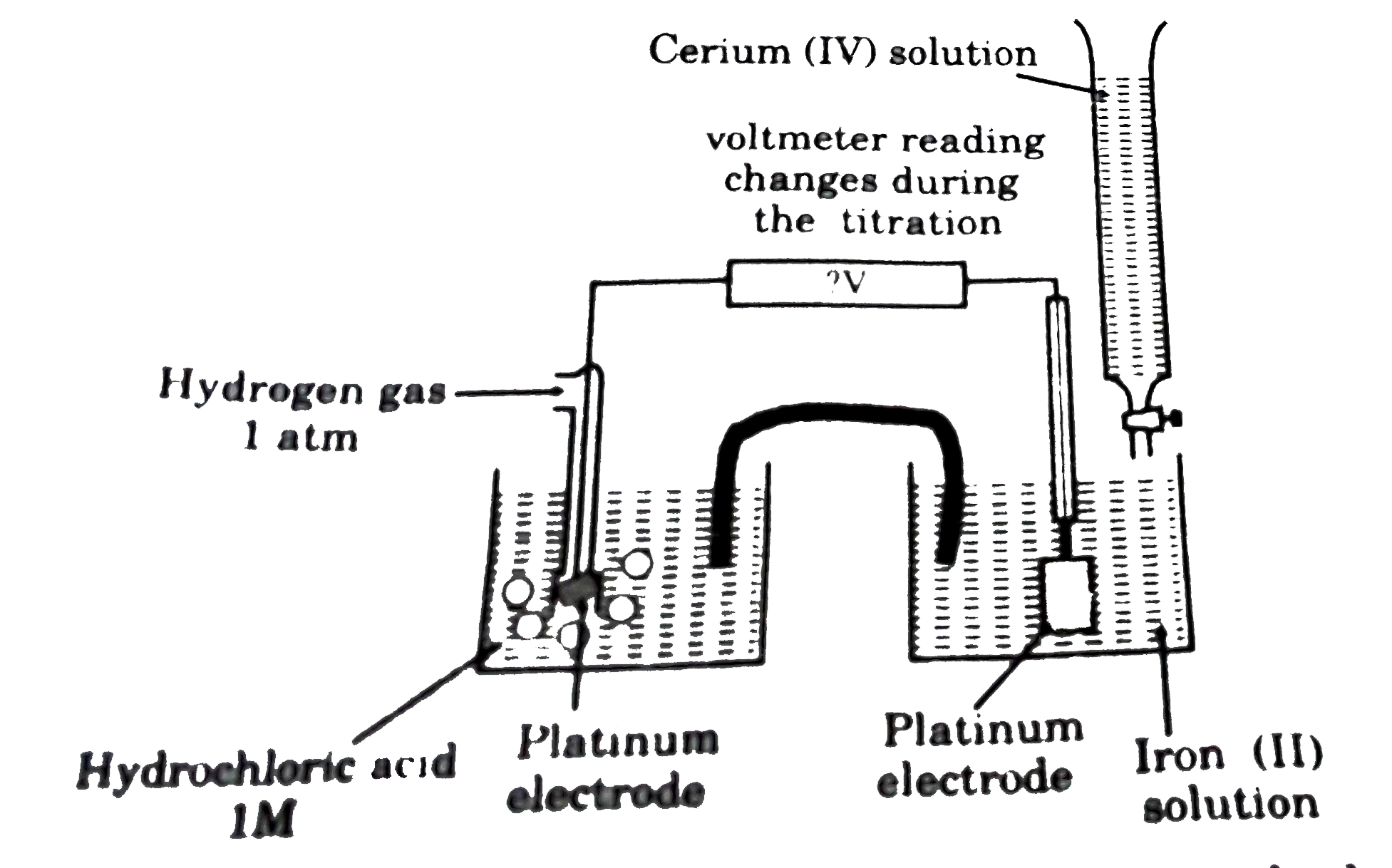
A perticularly well known example (Fig.) is a method of discovering then concentration of iron (II) ions in a solution by titrating them with a solution of cerium (IV). The redox potential that are of interest here areE∘Fe3+∣Fe2+=0.77VandE∘Ce4+∣Ce3+=1.61V. These tell us that cerium (IV) ions are the oxidising agents. They should react according to the equation
Fe2+(aq)+Ce4+(aq)→Fe3+(aq)+Ce3+(aq).
Now imagine that we know the concentration of the cerium (IV) ions solution in the burette. We want to measure the concentration of the cerium (IV) solution from the burette, some of the iron (II) ions are will be oxidised. As a consequence the beaker would now contain large number of unreacted iron (II) ions , but also some iron (III) ions as well. All of the cerium (III). The solution in the beaker now represents an iron (III)/iron(II) half cell although not at standard conditions.Thus , the emf of the cell will be near, but not equal to E∘Fe3+∣Fe2+.

If we continue to add cerium (IV) solution , the number of iron (II) ions is gradually reduced and eventually only a very few are left (Table).At this stage the next few drops of cerium (IV) solution convert all the remaining irom (II) ions into iron (III), and some of the cerium (IV) ions are left unreacted. Once this happens we no longer have an iron (III)/iron(II) half-cell. Instead we have a solution in which there is a large number of cerium (III) ions and a smaller number of cerium (IV) ions. The solution in the beaker now behaves as a cerium (IV)/cerium(III)half-cell (although not a standard one.)
Just before all the iron (II) ions are converted into iron (III) we have a cell with an EMF of around +0.77V. After all the iron (II) ions are oxidised we have a cell with an emf of about +1.61V. This rapid rise in emf occurs with the addition of just one drop of cerium (IV) solution. You should be able to understand why a graph of cell emf against volume of cerium (IV) solution of the iron (II) solution calculated in the usual way.
Imagine you were given a solution of potassium dichromate (VI) in a beaker and a solution of iron (II) sulphate in a burette. You do not know the concentration of dichromate (VI) ions , but the concentration of the iron (II) solution is known. Your task it to carry out a redox titration using the two solutions in order to determine the concentration of dichromate (VI) ions. Sketch a graph showing how the emf changes in the course of the above titration.
ECr2O2−7/Cr3+=1.33V,EFe3+/Fe2+=0.77VA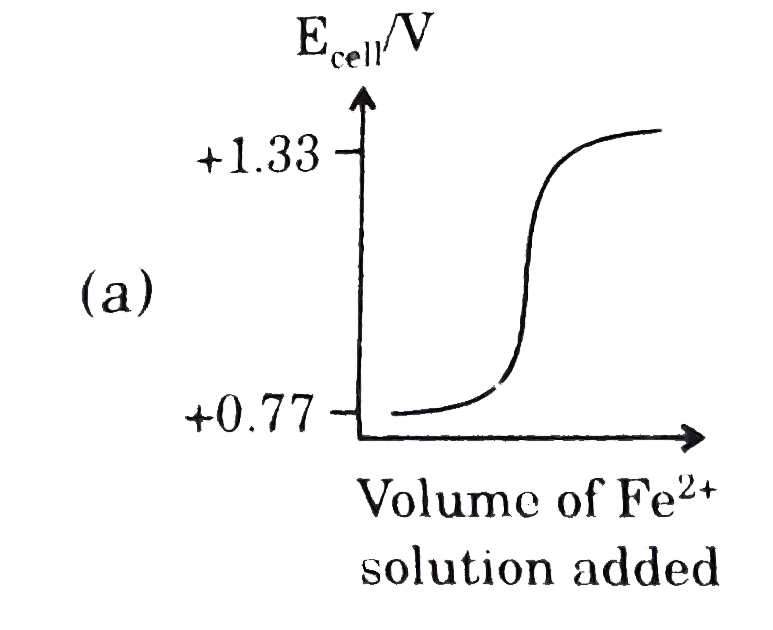 B
B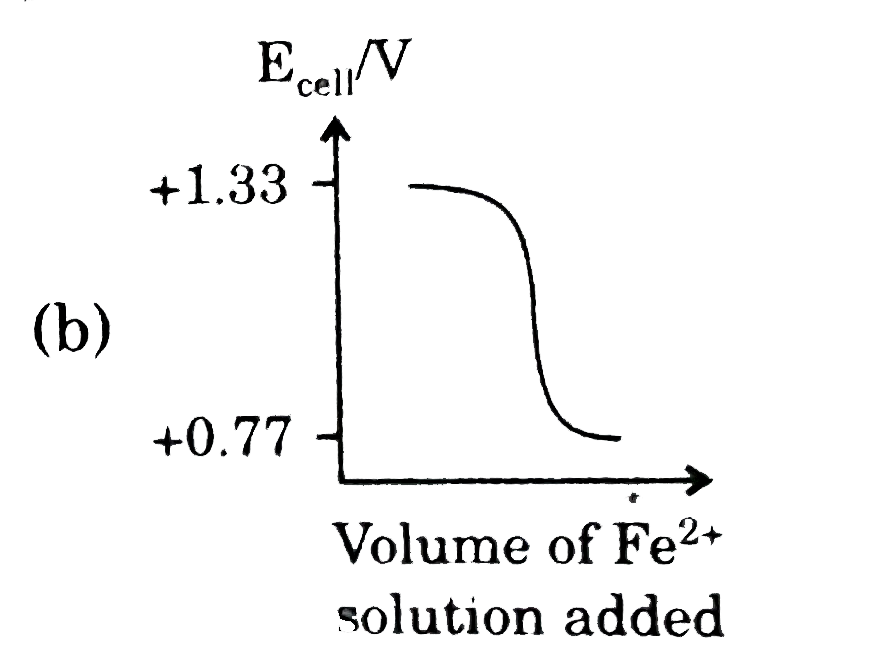 C
C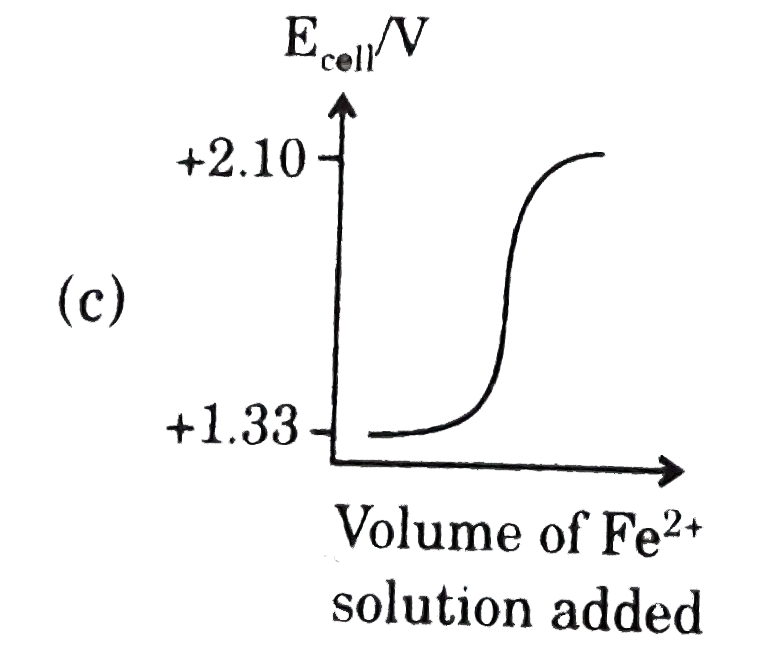 D
D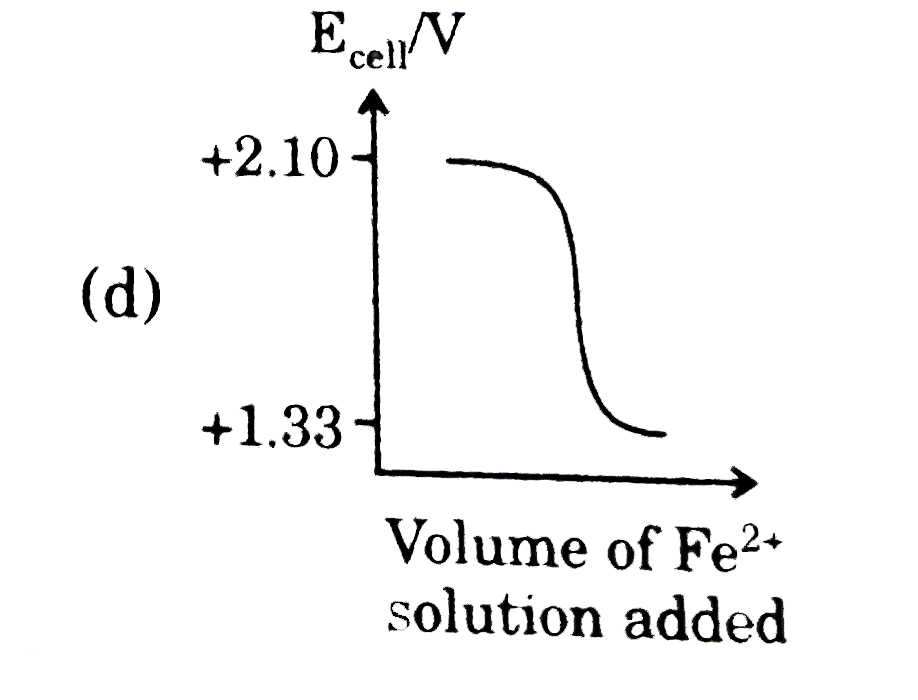
A new paper published by Rochman and her colleagues in February, in the journal Ecology, sifts through past research on marine debris to assess the true extent of the environmental threat. Plenty of studies have sounded alarm bells about the state of marine debris, Rochman and her colleagues set out to determine how many of those perceived risks are real.
Often, Rochman says, scientist will wrap up a paper by speculating about the broader impacts of what they ve found. Maybe their study has shown that certain seabirds eat plastic bags, for example, and the paper goes on the warm that whole bird populations are at risk of dying out. "But the truth was that nobody had yet tested those perceived threats, " Rochman says. "There wasn.t a lot of information."
Rochman and her colleagues examined more than a hundred papers on the impacts of marine debris that were published through 2013. Within each paper, they asked what threats scientist had studied - 366 perceived threats in all - and what they d actually found.
n 83 percent of cases, the perceived dangers of ocean trash were proved true. In most of the remaining cases, the working group found the studies too shoddy to draw conclusion from - they lacked a control group, for example, or used faulty statistics.
Strikingly, Rochman, says, only well-designed study failed to find the errect it was looking for, an investigation of mussels ingesting microscopic plastic bits. The plastic moved from the mussels. stomachs to their bloodstreams, scientists found, and stayd there for weeks- but didn.t seem to stress out the shellfish.
A lot of ocean debris is "microplastic," or pieces smaller than five millimetres. These may be the beads from a facial scrub, fibres shed by synthetic clothing in the was, or eroded remnants of large debris. Compared to the number of studies investigating large - scale debris, Rochman.s group found little research on the effects of these tiny bits.
There are also, she adds, a lot of open questions about the ways that ocean debris can lead to sea-creature death. Many studies have looked at how plastic affects an individual animal, or that animal.s tissues or cells, rather than whole populations. And in the lab, scientists often use higher concentrations of plastic than what.s really in the ocean. None of that tells us how many birds or fish or sea turtles could die from plastic pollution or how deaths in one species could affect that animal.s predators, or the rest of the ecosystem .
"we need to be asking more ecologically relevant questions," Rochman says. Usually, scientists don.t know how disasters like oil spills or nuclear meltdowns will affect the environment until after they ve happened, she says. "We don.t ask the right questions early enough." BUt if ecologists can understand how the slow - moving disaster of ocean garbage is affecting ecosystems, they might be able to prevent things from getting worse.
Which one of the following conclusions based on the examination of the hundred- odd papers on marine debris and its ecological impact by Rochman and her colleagues is not correct?AIssues with the focus, scope and findings of previous research inform future studiesBMore than fifty percent of the past ecological studies failed to perceive the threats posed by marine debrisCResearchers tend to over - generalize while discussing the implications of their findingsDThat ocean garbage endangers ecosystems has not been fully understood
A new paper published by Rochman and her colleagues in February, in the journal Ecology, sifts through past research on marine debris to assess the true extent of the environmental threat. Plenty of studies have sounded alarm bells about the state of marine debris, Rochman and her colleagues set out to determine how many of those perceived risks are real.
Often, Rochman says, scientist will wrap up a paper by speculating about the broader impacts of what they ve found. Maybe their study has shown that certain seabirds eat plastic bags, for example, and the paper goes on the warm that whole bird populations are at risk of dying out. "But the truth was that nobody had yet tested those perceived threats, " Rochman says. "There wasn.t a lot of information."
Rochman and her colleagues examined more than a hundred papers on the impacts of marine debris that were published through 2013. Within each paper, they asked what threats scientist had studied - 366 perceived threats in all - and what they d actually found.
n 83 percent of cases, the perceived dangers of ocean trash were proved true. In most of the remaining cases, the working group found the studies too shoddy to draw conclusion from - they lacked a control group, for example, or used faulty statistics.
Strikingly, Rochman, says, only well-designed study failed to find the errect it was looking for, an investigation of mussels ingesting microscopic plastic bits. The plastic moved from the mussels. stomachs to their bloodstreams, scientists found, and stayd there for weeks- but didn.t seem to stress out the shellfish.
A lot of ocean debris is "microplastic," or pieces smaller than five millimetres. These may be the beads from a facial scrub, fibres shed by synthetic clothing in the was, or eroded remnants of large debris. Compared to the number of studies investigating large - scale debris, Rochman.s group found little research on the effects of these tiny bits.
There are also, she adds, a lot of open questions about the ways that ocean debris can lead to sea-creature death. Many studies have looked at how plastic affects an individual animal, or that animal.s tissues or cells, rather than whole populations. And in the lab, scientists often use higher concentrations of plastic than what.s really in the ocean. None of that tells us how many birds or fish or sea turtles could die from plastic pollution or how deaths in one species could affect that animal.s predators, or the rest of the ecosystem .
"we need to be asking more ecologically relevant questions," Rochman says. Usually, scientists don.t know how disasters like oil spills or nuclear meltdowns will affect the environment until after they ve happened, she says. "We don.t ask the right questions early enough." BUt if ecologists can understand how the slow - moving disaster of ocean garbage is affecting ecosystems, they might be able to prevent things from getting worse.
Select the option to complete the statement below.
According to the passage, the significant difference between natural disasters and ecological disasters, especially with reference to marine debris, is that . . . . .
View SolutionA new paper published by Rochman and her colleagues in February, in the journal Ecology, sifts through past research on marine debris to assess the true extent of the environmental threat. Plenty of studies have sounded alarm bells about the state of marine debris, Rochman and her colleagues set out to determine how many of those perceived risks are real.
Often, Rochman says, scientist will wrap up a paper by speculating about the broader impacts of what they ve found. Maybe their study has shown that certain seabirds eat plastic bags, for example, and the paper goes on the warm that whole bird populations are at risk of dying out. "But the truth was that nobody had yet tested those perceived threats, " Rochman says. "There wasn.t a lot of information."
Rochman and her colleagues examined more than a hundred papers on the impacts of marine debris that were published through 2013. Within each paper, they asked what threats scientist had studied - 366 perceived threats in all - and what they d actually found.
n 83 percent of cases, the perceived dangers of ocean trash were proved true. In most of the remaining cases, the working group found the studies too shoddy to draw conclusion from - they lacked a control group, for example, or used faulty statistics.
Strikingly, Rochman, says, only well-designed study failed to find the errect it was looking for, an investigation of mussels ingesting microscopic plastic bits. The plastic moved from the mussels. stomachs to their bloodstreams, scientists found, and stayd there for weeks- but didn.t seem to stress out the shellfish.
A lot of ocean debris is "microplastic," or pieces smaller than five millimetres. These may be the beads from a facial scrub, fibres shed by synthetic clothing in the was, or eroded remnants of large debris. Compared to the number of studies investigating large - scale debris, Rochman.s group found little research on the effects of these tiny bits.
There are also, she adds, a lot of open questions about the ways that ocean debris can lead to sea-creature death. Many studies have looked at how plastic affects an individual animal, or that animal.s tissues or cells, rather than whole populations. And in the lab, scientists often use higher concentrations of plastic than what.s really in the ocean. None of that tells us how many birds or fish or sea turtles could die from plastic pollution or how deaths in one species could affect that animal.s predators, or the rest of the ecosystem .
"we need to be asking more ecologically relevant questions," Rochman says. Usually, scientists don.t know how disasters like oil spills or nuclear meltdowns will affect the environment until after they ve happened, she says. "We don.t ask the right questions early enough." BUt if ecologists can understand how the slow - moving disaster of ocean garbage is affecting ecosystems, they might be able to prevent things from getting worse.
Select the option that describes the central theme developed in the passage.
View SolutionA new paper published by Rochman and her colleagues in February, in the journal Ecology, sifts through past research on marine debris to assess the true extent of the environmental threat. Plenty of studies have sounded alarm bells about the state of marine debris, Rochman and her colleagues set out to determine how many of those perceived risks are real.
Often, Rochman says, scientist will wrap up a paper by speculating about the broader impacts of what they ve found. Maybe their study has shown that certain seabirds eat plastic bags, for example, and the paper goes on the warm that whole bird populations are at risk of dying out. "But the truth was that nobody had yet tested those perceived threats, " Rochman says. "There wasn.t a lot of information."
Rochman and her colleagues examined more than a hundred papers on the impacts of marine debris that were published through 2013. Within each paper, they asked what threats scientist had studied - 366 perceived threats in all - and what they d actually found.
n 83 percent of cases, the perceived dangers of ocean trash were proved true. In most of the remaining cases, the working group found the studies too shoddy to draw conclusion from - they lacked a control group, for example, or used faulty statistics.
Strikingly, Rochman, says, only well-designed study failed to find the errect it was looking for, an investigation of mussels ingesting microscopic plastic bits. The plastic moved from the mussels. stomachs to their bloodstreams, scientists found, and stayd there for weeks- but didn.t seem to stress out the shellfish.
A lot of ocean debris is "microplastic," or pieces smaller than five millimetres. These may be the beads from a facial scrub, fibres shed by synthetic clothing in the was, or eroded remnants of large debris. Compared to the number of studies investigating large - scale debris, Rochman.s group found little research on the effects of these tiny bits.
There are also, she adds, a lot of open questions about the ways that ocean debris can lead to sea-creature death. Many studies have looked at how plastic affects an individual animal, or that animal.s tissues or cells, rather than whole populations. And in the lab, scientists often use higher concentrations of plastic than what.s really in the ocean. None of that tells us how many birds or fish or sea turtles could die from plastic pollution or how deaths in one species could affect that animal.s predators, or the rest of the ecosystem .
"we need to be asking more ecologically relevant questions," Rochman says. Usually, scientists don.t know how disasters like oil spills or nuclear meltdowns will affect the environment until after they ve happened, she says. "We don.t ask the right questions early enough." BUt if ecologists can understand how the slow - moving disaster of ocean garbage is affecting ecosystems, they might be able to prevent things from getting worse.
What, according to the author, is the problem, with papers reporting seabirds eating plastic ?
View SolutionThe process in which solution containing more than one typeof ions (either cation or anion) and in which one ion undergoes almst complete precipitation followed by the second ion and similarly second ion undergoes complete precipitation followed by the third ion is known as preferential precipitation. It is the solubility of the salt,not the solubility product of the salt, by means of which one can predict the preferential precipitation of the salt or ion among the lot of ions in the solution. For example , in a solution containing Cl−,Br− and I− ions, if Ag+ ions are added, then out of three , the less soluble salt is precipitated first . If the addition of Ag+ ions is continued, eventually , a stage is reached when the next lesser soluble salt starts precipitating along with the least soluble salt and so on.
If the stiochiometry of the salt is same, then the salt with the minimum Ksp ( solubility product ) will have minimum solubility and will precipitate first, followed by the salt of next higher solubility product and so on. If the stiochiometry of teh salt is not same, then from the solubility product data alone, we cannot predict which ions will precipitate first. For example, a solution containing Cl− and CrO2−4. In order to predict which ion will precipitate first, we have to calculate the amount of Ag+ ions needed to start precipitation through the solubility product data given. When AgNO93) is added to the solution, the minimum of the two concentrations needed to start the precipitation will be reached and thus corresponding [Ag+] to start the precipitation increases. Its concentration eventually becomes equal to the value required for CrO2−4 . At this stage, practically almost the whole of Cl− ions get precipitated . Addition of more AgNO3 causes simultaneous precipitation of both the ions together.
Suppose a student of chemistry performs the following two sets of experiments in order to known the preferential precipitation of ions as well as its precipitated percentage amount.
Experiment 1. He prepare a solution of anions composed of 0.1 M each of Cl−,Br− and I− . Further he adds gradually solid AgNO3 to this solution. He assumes that volume of the solution does not change after the addition of solid AgNO3(KspAgCl=1.0×10−9M2,KspAgBr=10−10M2 and KspAgI=10−12M2)
Experiment -2. He prepares a solution of cations Cd2+(0.2M) and Bi3+(0.3m) . Now he adds S2− ions into the solution of cations in order to separate them by selective precipitation Cd2+forms yellow precipitate of CdS and Bi3+ forms black precipitate of Bi2S3 with S2− ions respectively.
(KspBi2S3=9×10−25M5 and KspCdS=2×10−20M2).Answer the following questions ont he basis of the above write up.
Which of the following will precipitate first in experiment -1 ?
View SolutionThe process in which solution containing more than one typeof ions (either cation or anion) and in which one ion undergoes almst complete precipitation followed by the second ion and similarly second ion undergoes complete precipitation followed by the third ion is known as preferential precipitation. It is the solubility of the salt,not the solubility product of the salt, by means of which one can predict the preferential precipitation of the salt or ion among the lot of ions in the solution. For example , in a solution containing Cl−,Br− and I− ions, if Ag+ ions are added, then out of three , the less soluble salt is precipitated first . If the addition of Ag+ ions is continued, eventually , a stage is reached when the next lesser soluble salt starts precipitating along with the least soluble salt and so on.
If the stiochiometry of the salt is same, then the salt with the minimum Ksp ( solubility product ) will have minimum solubility and will precipitate first, followed by the salt of next higher solubility product and so on. If the stiochiometry of teh salt is not same, then from the solubility product data alone, we cannot predict which ions will precipitate first. For example, a solution containing Cl− and CrO2−4. In order to predict which ion will precipitate first, we have to calculate the amount of Ag+ ions needed to start precipitation through the solubility product data given. When AgNO93) is added to the solution, the minimum of the two concentrations needed to start the precipitation will be reached and thus corresponding [Ag+] to start the precipitation increases. Its concentration eventually becomes equal to the value required for CrO2−4 . At this stage, practically almost the whole of Cl− ions get precipitated . Addition of more AgNO3 causes simultaneous precipitation of both the ions together.
Suppose a student of chemistry performs the following two sets of experiments in order to known the preferential precipitation of ions as well as its precipitated percentage amount.
Experiment 1. He prepare a solution of anions composed of 0.1 M each of Cl−,Br− and I− . Further he adds gradually solid AgNO3 to this solution. He assumes that volume of the solution does not change after the addition of solid AgNO3(KspAgCl=1.0×10−9M2,KspAgBr=10−10M2 and KspAgI=10−12M2)
Experiment -2. He prepares a solution of cations Cd2+(0.2M) and Bi3+(0.3m) . Now he adds S2− ions into the solution of cations in order to separate them by selective precipitation Cd2+forms yellow precipitate of CdS and Bi3+ forms black precipitate of Bi2S3 with S2− ions respectively.
(KspBi2S3=9×10−25M5 and KspCdS=2×10−20M2).Answer the following questions ont he basis of the above write up.
What percent of the anions Br− and I− get precipitated respectively when the third ion starts precipitating in experiment -1 ?
View Solution
